Related Research Articles
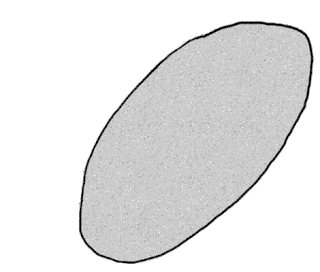
In archaeology, in particular of the Stone Age, lithic reduction is the process of fashioning stones or rocks from their natural state into tools or weapons by removing some parts. It has been intensely studied and many archaeological industries are identified almost entirely by the lithic analysis of the precise style of their tools and the chaîne opératoire of the reduction techniques they used.

In archaeology, a lithic flake is a "portion of rock removed from an objective piece by percussion or pressure," and may also be referred to as simply a flake, or collectively as debitage. The objective piece, or the rock being reduced by the removal of flakes, is known as a core. Once the proper tool stone has been selected, a percussor or pressure flaker is used to direct a sharp blow, or apply sufficient force, respectively, to the surface of the stone, often on the edge of the piece. The energy of this blow propagates through the material, often producing a Hertzian cone of force which causes the rock to fracture in a controllable fashion. Since cores are often struck on an edge with a suitable angle (x<90°) for flake propagation, the result is that only a portion of the Hertzian cone is created. The process continues as the flintknapper detaches the desired number of flakes from the core, which is marked with the negative scars of these removals. The surface area of the core which received the blows necessary for detaching the flakes is referred to as the striking platform.
In lithic analysis, a subdivision of archaeology, a bulb of applied force is a defining characteristic of a lithic flake. Bulb of applied force was first correctly described by Sir John Evans, the cofounder of prehistoric archeology. However, bulb of percussion was coined scientifically by W.J. Sollas. When a flake is detached from its parent core, a portion of the Hertzian cone of force caused by the detachment blow is detached with it, leaving a distinctive bulb on the flake and a corresponding flake scar on the core. In the case of a unidirectional core, the bulb of applied force is produced by an initiated crack formed at the point of contact, which begins producing the Hertzian cone. The outward pressure increases causing the crack to curve away from the core and the bulb formation. The bulb of applied force forms below the striking platform as a slight bulge. If the flake is completely crushed the bulb will not be visible. Bulbs of applied force may be distinctive, moderate, or diffuse, depending upon the force of the blow used to detach the flake, and upon the type of material used as a fabricator. The bulb of applied force can indicate the mass or density of the tool used in the application of the force. The bulb may also be an indication of the angle of the force. This information is helpful to archaeologists in understanding and recreating the process of flintknapping. Generally, the harder the material used as a fabricator, the more distinctive the bulb of applied force. Soft hammer percussion has a low diffuse bulb while hard hammer percussion usually leaves a more distinct and noticeable bulb of applied force. Pressure flake also allowed for diffuse bulbs. The bulb of percussion of a flake or blade is convex and the core has a corresponding concave bulb. The concave bulb on the core is known as the negative bulb of percussion. Bulbs of applied force are not usually present if the flake has been struck off naturally. This allows archaeologists to identify and distinguish natural breakage from human artistry. The three main bulb types are flat or nondescript, normal, and pronounced. A flat or nondescript bulb is poorly defined and does not rise up on the ventral surface. A normal bulb on the ventral side has average height and well-defined. A pronounced bulb rises up on ventral side and is very large.
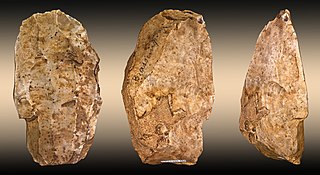
In archaeology, a lithic core is a distinctive artifact that results from the practice of lithic reduction. In this sense, a core is the scarred nucleus resulting from the detachment of one or more flakes from a lump of source material or tool stone, usually by using a hard hammer precursor such as a hammerstone. The core is marked with the positive scars of these flakes. The surface area of the core which received the blows necessary for detaching the flakes is referred to as the striking platform. The core may be discarded or shaped further into a core tool, such as can be seen in some types of handaxe.
In archaeology, a prismatic blade is a long, narrow, specialized stone flake tool with a sharp edge, like a small razor blade. Prismatic blades are flaked from stone cores through pressure flaking or direct percussion. This process results in a very standardized finished tool and waste assemblage. The most famous and most prevalent prismatic blade material is obsidian, as obsidian use was widespread in Mesoamerica, though chert, flint, and chalcedony blades are not uncommon. The term is generally restricted to Mesoamerican archaeology, although some examples are found in the Old World, for example in a Minoan grave in Crete.
In lithic reduction, the striking platform is the surface on the proximal portion of a lithic flake on which the detachment blow falls; this may be natural or prepared. Types of striking platforms include:

A stone tool is, in the most general sense, any tool made either partially or entirely out of stone. Although stone tool-dependent societies and cultures still exist today, most stone tools are associated with prehistoric cultures that have become extinct. Archaeologists often study such prehistoric societies, and refer to the study of stone tools as lithic analysis. Ethnoarchaeology has been a valuable research field in order to further the understanding and cultural implications of stone tool use and manufacture.
In archaeology, lithic analysis is the analysis of stone tools and other chipped stone artifacts using basic scientific techniques. At its most basic level, lithic analyses involve an analysis of the artifact’s morphology, the measurement of various physical attributes, and examining other visible features.
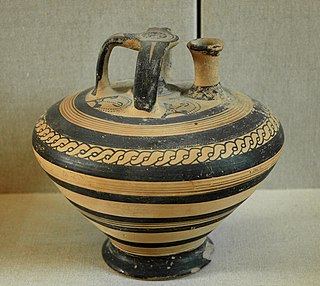
An artifact, or artefact, is a general term for an item made or given shape by humans, such as a tool or a work of art, especially an object of archaeological interest. In archaeology, the word has become a term of particular nuance and is defined as an object recovered by archaeological endeavor, which may be a cultural artifact having cultural interest.

In archaeology, a blade is a type of stone tool created by striking a long narrow flake from a stone core. This process of reducing the stone and producing the blades is called lithic reduction. Archaeologists use this process of flintknapping to analyze blades and observe their technological uses for historical purposes.
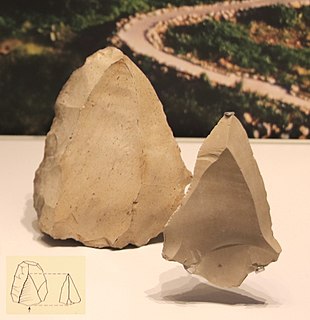
The Levallois technique is a name given by archaeologists to a distinctive type of stone knapping developed around 250,000 to 300,000 years ago during the Middle Palaeolithic period. It is part of the Mousterian stone tool industry, and was used by the Neanderthals in Europe and by modern humans in other regions such as the Levant.
The term Hòa Bình culture was first used by French archaeologists working in Northern Vietnam to describe Holocene period archaeological assemblages excavated from rock shelters. The related English adjective Hoabinhian became a common term in the English-based literature to describe stone artifact assemblages in Southeast Asia that contain flaked, cobble artifacts, dated to c. 10,000–2000 BCE. The term was originally used to refer to a specific ethnic group, restricted to a limited period with a distinctive subsistence economy and technology. More recent work uses the term to refer to artifacts and assemblages with certain formal characteristics. However, in 2016 a rockshelter was identified in Yunnan (China), where artifacts belonging to the Hoabinhian technocomplex were recognized, suggesting they lived in parts of Northern Vietnam and Southern China. These artifacts date from 41,500 BCE.
Retouch is the act of producing scars on a stone flake after the ventral surface has been created. It can be done to the edge of an implement in order to make it into a functional tool, or to reshape a used tool. Retouch can be a strategy to reuse an existing lithic artifact and enable people to transform one tool into another tool. Depending on the form of classification that one uses, it may be argued that retouch can also be conducted on a core-tool, if such a category exists, such as a hand-axe.
In archaeology, lithic technology includes a broad array of techniques used to produce usable tools from various types of stone. The earliest stone tools were recovered from modern Ethiopia and were dated to between two-million and three-million years old. The archaeological record of lithic technology is divided into three major time periods: the Paleolithic, Mesolithic, and Neolithic. Not all cultures in all parts of the world exhibit the same pattern of lithic technological development, and stone tool technology continues to be used to this day, but these three time periods represent the span of the archaeological record when lithic technology was paramount. By analysing modern stone tool usage within an ethnoarchaeological context, insight into the breadth of factors influencing lithic technologies in general may be studied. See: Stone tool. For example, for the Gamo of Southern Ethiopia, political, environmental, and social factors influence the patterns of technology variation in different subgroups of the Gamo culture; through understanding the relationship between these different factors in a modern context, archaeologists can better understand the ways that these factors could have shaped the technological variation that is present in the archaeological record.

In archaeology, a flake tool is a type of stone tool that was used during the Stone Age that was created by striking a flake from a prepared stone core. People during prehistoric times often preferred these flake tools as compared to other tools because these tools were often easily made, could be made to be extremely sharp & could easily be repaired. Flake tools could be sharpened by retouch to create scrapers or burins. These tools were either made by flaking off small particles of flint or by breaking off a large piece and using that as a tool itself. These tools were able to be made by this "chipping" away effect due to the natural characteristic of stone. Stone is able to break apart when struck near the edge. Flake tools are created through flint knapping, a process of producing stone tools using lithic reduction. Lithic reduction is the removal of a lithic flake from a larger stone in order to reach the desired tool shape and size. The beginning stone is called the flake lithic core. There are three steps to lithic reduction:
- Hard hammer percussion is the first step. It involves knocking off the larger flakes to achieve the desired lithic core for the flake tool. In using hard hammer percussion the flake tools were made by taking metamorphic or igneous rock such as granite or quartz and striking it against the stone. This method was often used to flake large core flakes of hard rock.
- Soft hammer percussion is the second step. It involves using a hammer made of bone, which was often antler, in order to knock off flakes from the lithic core. Animal antlers such as moose, deer and elk were often the most common ones used. It allows the user more control over the size and shape of the flake knocked off. Soft hammer percussion was also used when the stone was more brittle.
- Pressure flaking is the final step. It involves using a piece of bone, antler, or piece of hardwood in order to have more control of the flakes knocked off of the lithic core. One simply applies outward and downward pressure to achieve the final flake tool.
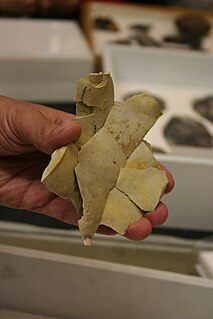
In archaeology, debitage is all the material produced during the process of lithic reduction - the production of stone tools and weapons by knapping stone. This assemblage may include the different kinds of lithic flakes and lithic blades, but most often refers to the shatter and production debris, and production rejects.
Peter Dixon Hiscock is an Australian archaeologist. Born in Melbourne, he obtained a PhD from the University of Queensland. Since 2013, he has been the Tom Austen Brown Professor of Australian Archaeology at the University of Sydney, having previously held a position in the School of Archaeology and Anthropology at the Australian National University.

Mumba Cave, located near the highly alkaline Lake Eyasi in Karatu District, Arusha Region, Tanzania. The cave is a rich archaeological site noted for deposits spanning the transition between the Middle Stone Age and Late Stone Age in Eastern Africa. The transitional nature of the site has been attributed to the large presence of its large assemblage of ostrich eggshell beads and more importantly, the abundance of microlith technology. Because these type artifacts were found within the site it has led archaeologists to believe that the site could provide insight into the origins of the modern human behavior. The cave was originally tested by Ludwig Kohl-Larsen and his wife Margit in their 1934 to 1936 expedition. They found abundant artifacts, rock art, and burials. However, only brief descriptions of these findings were ever published. That being said, work of the Kohl-Larsens has been seen as very accomplished due to their attention to detail, especially when one considers that neither was versed in proper archaeological techniques at the time of excavation. The site has since been reexamined in an effort to reanalyze and complement the work that has already been done, but the ramifications of improper excavations of the past are still being felt today, specifically in the unreliable collection of C-14 data and confusing stratigraphy.
Located in the upper Gunnison basins Tenderfoot is a prehistoric or Archaic site that was excavated by Mark Stiger, with assistance from facility and students at Western State College. The site is located in Gunnison, Colorado on a low ridge that extends west from Tenderfoot Mountain overlooking the joining of the Gunnison and Tomichi River.
Paul Barry Pettitt, FSA is a British archaeologist and academic. He specialises in the Palaeolithic era, with particular focus on claims of art and burial practices of the Neanderthals and Pleistocene Homo sapiens, and methods of determining the age of artefacts from this time. Since 2013, he has been Professor of Archaeology at Durham University. He previously taught at Keble College, Oxford and the University of Sheffield.